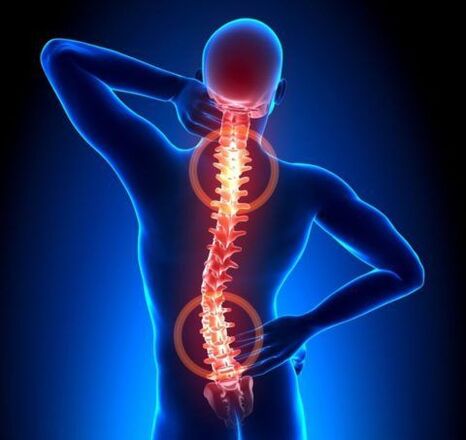
Many 30-35 people complain about back pain.The cause of this pain may be spinal disease.Osteochondrosis is a disease that occurs in middlemen, but more often it is detected in patients after 40 years.
Osteochondrosis - what is the disease, and what is the danger?
This term means the process of dystrophic cartilage and subject bone tissue.In modern medical practice, osteochondrosis is called degenerative-dystrophic disease and intervertebral discs that play the role of shock absorber.The danger of the disease is that the affected disc is almost impossible to restore, and without proper treatment, defects are possible.
Osteochondrosis is a common disease?Stats are not happy.About 85% of the world's population suffers from this disease.
The disease is the most common form of all diseases that affect the spine.And according to the prevalence, it is immediately after the cardiovascular system disease.
The essence of the disease
So, osteochondrosis - what is it?This is a chronic disease that affects the joints, usually the spine.
The spinal column consists of 24 vertebrae.Between the two vertebrae are the disc, the purpose is to gentle and depreciation.
Under normal circumstances, the disc is quite elastic and can withstand significant loads.In the middle of the disc there is a pulp nucleus with plenty of water.For some reason, the core loses its hydrophilic properties.
As a result, disc delays, height decreases and deformation.In later stages, bone tissue growth occurs with the formation of growth - osteophytes that compress the peripheral nerve and spinal cord.This is the spinal osteochondrosis.
The cause of the pathology
Although osteochondrosis is a relatively common disease, the reason why pathology develops is not fully established.

The main factors are considered:
- Excessive load on the spine;
- injury;
- Professional damage - lifting weight or prolonged work in uncomfortable and non -moving pose;
- excess weight;
- descendants;
- Posture violations.
Osteochondrosis develops into one degree or another in almost all parents and is one of the processes of body aging.
Stage, form and symptoms of disease progression
Experts distinguish 4 stages of illness:
- Stage 1- move the nucleus of the disc to the edge;
- Level 2- cracks in cartilage and vertebral instability;
- Stage 3- complete breaks of discs with nucleus loss in the spinal cord, while the spinal cord root is possible;
- The 4th stage- Rough changes are not only in the intervertebral disc, but also in the surrounding fabric.
The main symptom of the disease is pain.It can be acute with high intensity or moderate, moderate manifestation.
In addition to pain, there are:
- Tension that hurts the back muscles;
- numbness of the skin on the arms and legs;
- Limitations of total movement;
- weakness in the muscles of the limbs;
- Deplicity of arms and legs;
- Dizzy suddenly.
This is a general manifestation of all forms of pathology.Depending on the spine where the change is localized, three forms of disease with the characteristic symptoms are distinguished.
Table No.1. The form of osteochondrosis and existing symptoms:
| A form of a disease | Symptom |
| Osteochondrosis in the neck | Changes in this department lead to rejecting blood vessels and micro -circulation.For this reason, one has a constant dizziness.Sometimes this leads to fainting.There is a sound in the ear and blinking the colored spots in front of the eyes. |
| Osteochondrosis in thorax vertebrae | With this form of disease, acute chest pain is observed.The disease can cause the development of intercostal neuralgia and exacerbate heart pathology. |
| Osteochondrosis in the lumbar region | Pathology in the lower back is characterized by pain in the gluteal region, a decrease in IKR tone.Complications can be radiculite, accompanied by pain spreading throughout the legs. |
Due to the pathology of the vertebral disc, a large number of disorders in the body occur: pinching nerves, swelling, blood circulation violations, and surrounding tissue fibrosis.These changes cause a variety of symptoms, which complicate the diagnosis and prescribe appropriate treatment without careful examination.
Clinical manifestations
Symptoms -The symptoms of the disease depend on the place where the lesion is located.In the below section, we consider the characteristics of each of the various diseases.
Cervical department
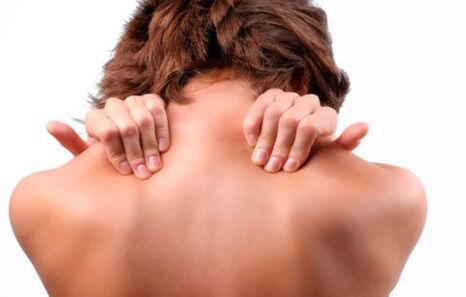
The main symptoms of damage to the cervical spine include:
- discomfort, pain in the neck and shoulders;
- Muscle hypotonus;
- increased sweating;
- finger numbness;
- violations of movement coordination;
- headache, dizziness;
- Problems with hearing and vision;
- Hypertension.
With the development of the disease and damage to the nearby arteries and nerves, one of the following syndrome can develop:
- vertebral artery;
- Heart;
- hypertension;
- root;
- Cervical migraines.
Violation of blood circulation in the artery of the vertebra and hypoxia of the brain tissue is a dangerous result of osteochondrosis.
This syndrome shows itself:
- Periodic system/dizziness;
- Disadvantages of vision;
- loss of partial or complete hearing;
- Sometimes - fainting.
IMPORTANT!Neurological manifestations of spinal osteochondrosis often need to distinguish with brain atherosclerosis, dep and other pathologies.
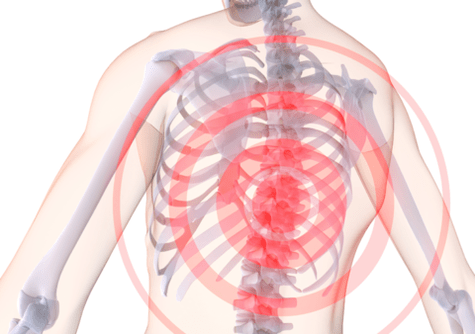
Thoracic province
Compared to other forms of disease, thoracic osteochondrosis is indicated.
Between symptoms:
- chest pain, increased at night or by prolonged in one position;
- discomfort, squeezing feelings between shoulder blades;
- Strengthen pain during deep breathing.
If the disease is not treated, it will develop, causing damage to nearby and nearby nerves.
Signs -Development of Complications of Spinal Osteochondrosis This localization can be:
- skin numbness in some areas, the feeling of crawling "goosebumps";
- Itching -itchy, burns;
- Refrigeration of limbs;
- nail polish;
- is said to be dry skin;
- pain along the esophagus and pharynx;
- Disruption of the gastrointestinal tract.
In addition, the chest localization of the disease is characterized by two specific symptoms - dorsago and dorsalgia.
Dorsago is a chest pain, sharp, sharp and very intense, "thoracic transition".It can happen by prolonged in the same position, a boring work.
Note!During breast milk, the pain is so severe that the patient is afraid to take additional inhalation.
Dorsalgia is less intense, but painful sensations can last up to 2-3 weeks.They are intensified by deep breathing, tendency.
Lumbar department
Osteochondrosis of the lower spine, the lumbar, occupies a major position at the prevalence.
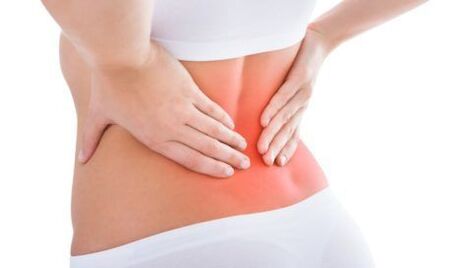
Among the symptoms of its characteristics:
- boring, more frequent back pain, radiating in the feet;
- discomfort, increasing when changing body position, sneezing, coughing, trying to lift weight;
- persistent muscle cramps in the lower back;
- Lamp at the bottom;
- Impaired sensitivity to skin, hips, feet, feet;
- the feeling of creeping goosebumps on the lower leg;
- Dry, peel off the skin.
Department of Sacral
Sacral spinal osteochondrosis is extremely rare in an isolated way and is usually "continuity" of lower lumbar damage.
This describes the features of the stray:
- lower back pain, as well as in the sealing nerve;
- Sharp "Shelters" through the whole leg;
- discomfort behind the thighs;
- numbness from lower limbs;
- Paresis, as well as unstable symptoms of affected motor activity.
IMPORTANT!Lower spinal osteochondrosis can cause very dangerous complications such as impaired blood supply to the spinal cord and compression myelopathy.

Common osteochondrosis
The same form, or osteochondrosis of all parts of the spine is the worst version of the pathology.Due to the extensive defeat, the picture can be very diverse and includes almost all of the symptoms described above.
Diagnostic method
The appearance of any complaints shown above requires an appeal to the medical institution: the patient must examine the patient.The diagnosis of osteochondrosis should be complex and very careful.
Standard instructions include the following stages:
- Collection of complaints and anamnesis.
- Clinical examination.
- Exam X -Ray.
- Modern method (CT, MRI).
Running a conversation with the patient, the doctor should know:
- which interferes with the patient;
- What is the most unpleasant place of sensation;
- What are their intensity and duration;
- which creates their strengthening;
- that helps overcome pain.
IMPORTANT!Make sure you tell your doctor how long you are worried about the complaint, and whether you receive any treatment earlier.
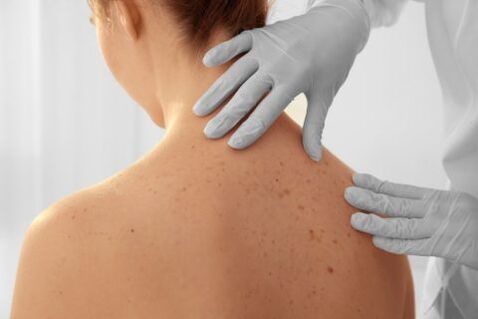
During clinical examination, experts evaluate:
- the position of the patient's body, his lifestyle, the amount of active and passive movement;
- presence of skin defects, redness, peeling;
- symmetry of healthy and sick body parts;
- presence of muscle cramps;
- pain irradiation area;
- The presence of pain, temperature and other types of sensitivity.
During radiography, each spine for better visualization is studied individually.The picture is done live, the side and (according to the instructions) of two oblique projections.To assess the degree and severity of degenerative-dystrophic changes, the zeaker spinal osteochondrosis classification is used.
Table: Stage x osteochondrosis of the spinal cord:
| Phase | Information |
| I (+) | Unsecured changes in lordosis in a small number of segments |
| II (++) |
|
| III (+++) | Expressing changes, significant narrowing of intervertebral holes |
| IV (++++) | Significant narrowing of the intervertebral hole, large exostosis -an, often irreversible |
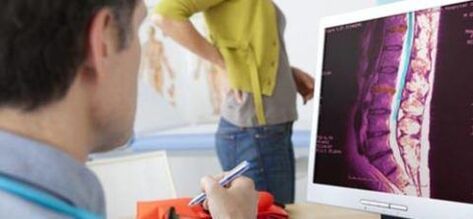
With inadequate information content, patients can be prescribed more modern-CT tests (an image targeted at one or more segments of the spinal column) and MRI (visual diagnostic methods based on electromagnetic radiation properties).
Treatment
First of all, the doctor explains to the patient what osteochondrosis is and how to treat it.He talks about a set of steps that must be taken for a long time.
Disease therapy is performed taking into account the stage.In the early days of the disease, massage, physiotherapy, physiotherapy exercises are indicated.But during the dystrophic process, various orthopedic devices for the spine should be used.Drug treatment is also required.
Surgical intervention is indicated by complications and ineffective conservative treatment.
Medication
The most important task of treatment with pharmacological medications is pain relief, eliminating nerve root inflammation, restoring cartilage structure, improving blood circulation and nutrition, stopping pathological development.There are several groups of drugs that can be prescribed in this case.
In pharmacies, they are represented in many forms and in many types.Medication prices can be different and you can always choose the most affordable.
Table No.2. Medicines used in conservative therapy osteochondrosis:
| A group of pharmacology | Therapeutic effect | Instructions for use |
| Chondroprotectors | Slowly the process of deteriorating the cartilage, contributing to its recovery. | Take 1 capsule for a month.If necessary, the course of treatment is repeated. |
| Nsaid | It has an anesthetic effect, reducing the inflammation process. | Take a tablet for pain.With severe pain, intramuscular injection of the drug is used. |
| B Vitamins | Increase the conductivity of nerve impulses, restoring micro -circulation in the affected cartilage area. | The course of treatment with intramuscular injection is performed. |
| Musorelaxants | Loosen the muscles, relieve tension, facilitate pain. | Take one tablet 2 times a day. |
The drug is prescribed according to the doctor's testimony.Self can be ineffective, and in some cases even harm.
Physiotherapy for osteochondrosis
What to do with osteochondrosis, except for medicine, to speed up recovery?One of the most effective ways to treat the disease is physiotherapy.
The advantage is the selected effect of the focus of the disease.Contribution to physiotherapy to reduce pain, removal of inflammation, and increase general immunity.With their help, the muscles relax, the metabolic processes and blood circulation are normalized.
For osteochondrosis, they are successfully used:
- magnetotherapy;
- laser therapy;
- shock wave therapy;
- quartz;
- electrophoresis;
- Effect of low frequency electric current.
Physiotherapy is not performed if the patient is in serious condition, with increased disease, oncological disease, and mental disorders. In other cases, physiotherapy has a good effect on the recovery process, improving the effects of medication, which reduces their dose.
In other cases, physiotherapy has a good effect on the recovery process, improving the effects of medication, which reduces their dose.
Physical Education Medicine
Physical Education Classes are prohibited during acute disease.After eliminating this period, the doctor prescribes therapeutic training, which develops together with the instructor individually for each patient.
With the help of exercise, the muscle corset is strengthened, which prevents spinal curvature and allows you to distribute the load properly and evenly on the vertebra.With frequent physical energy, medical materials penetrate the spine at a higher concentration than their absence.
It is necessary to engage in the guidance of experienced teachers and to monitor their circumstances.With severe discomfort and pain, exercise should be stopped.
Prevention
Knowing what osteochondrosis is and as a result, it is useful to think about prevention.
Steps -Prevention Steps are simple, they are easy to do to everyone who cares about their health:
- injury prevention;
- Frequent physical training (swimming is very useful);
- maintaining normal weight;
- Do not load the spine;
- Monitor the accuracy of posture;
- cannot be in one position for a long time;
- Avoid movements suddenly when lifting weights.
When fulfilling this rule, the remission period will be long.
Osteochondrosis is a serious disease.But timely looking for a doctor and adequate treatment, it is possible to stop the damaging effect.
Questions to the doctor
Pain in the neck
Hello, tell me.I'm 24 years old.Over the past few months, pain in the neck, back of the head (sometimes still giving whiskey, eyes).I also see strong problems in the neck, tingling and numbness of hands, tongues, and sky.
I suspect osteochondrosis, because both mothers and grandmothers of youth are tortured by the same symptoms.Where to start the exam?And another question: Can I go to aerobics?
Create a R-SKIM (CT) shop and doppler head and neck ships.You may develop vertebral artery syndrome against the background of cervical osteochondrosis.Further plans for diagnosis and treatment can be made only after the results of this test.
It's best not to visit aerobics anymore.
Lumbar osteochondrosis
For seven years I have been tortured with the lower back, an increase in osteochondrosis almost every 2-3 months.Injections and tablets help for a short time, and then the pain returns.I work as a postman, it's getting harder.Did I put a defect?
Hello!The decision on the Disabled Group Award was made therefore on the basis of a comprehensive study of your situation.Starting you should contact the therapist and undergo an examination.
As a rule, with lumbar osteochondrosis, the defect group is not indicated.The awards may be with the development of complications (protrusions, intervertebral hernia, and others).But, again, I repeat, all are individuals here.

























